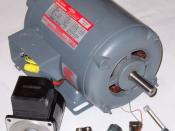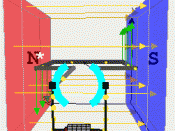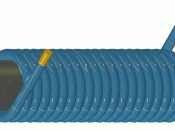A Direct Current Motor has 6 essential parts: armature, or rotor; commutator; brushes; axle; field magnet; and a DC power supply. With an understanding of magnets and magnetism, these 6 parts become a motor.The first step in understanding a dc motor is an electromagnet. An electromagnet is a magnet consisting, essentially, of a coil of insulated wire wrapped around a soft iron core that is magnetized only when current flows through the wire. Simple put, an electromagnet is a piece of metal, in a rectangular shape, with a wire coiled around it. Once a DC power source is put through the wire, an electromagnet is created.
Placed within a permanent magnet,
the electromagnet's poles are attracted to its opposites. This creates a half turn. In order to create constant motion a flip is needed.
To create this "flip", something called a commutator is needed. This allows the current to switch making the poles of the electromagnet reverse.
This creates the rest of the half turn. By putting all this information together, a simple DC motor is formed. There are many adaptations such as multiple poles and different ways of flipping the current. These advancements became more and more complex with time, eventual evolving into the electric motors so widely used today. After the invention of the induction motor, alternating current machines largely replaced DC machines in most applications. However, DC motors still have many uses. After more than a century, DC motors are still in widespread use and thanks to many limited space applications that show no signs of disappearing, they'll be around for many years to come



Motor
This was very informative, and accurate, as I have recently studied a unit on how motors work. It was good, but it lacked the form of a standard essay.
5 out of 5 people found this comment useful.